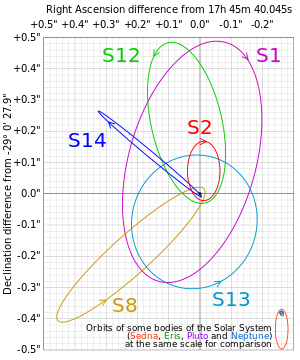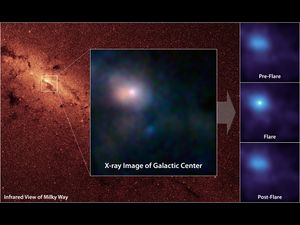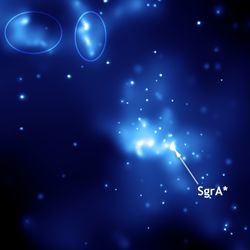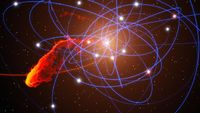القوس أ*
| بيانات الرصـد الحقبة J2000 اعتدال J2000 | |
|---|---|
| الكوكبة | الرامي |
| الصعود المستقيم | 17h 45m 40.0409s |
| الميل | −29° 0′ 28.118″ [1] |
| التـفـاصـيل | |
| الكتلة | (4.31 ± 0.38) × 106[2] M☉ (4.1 ± 0.6) × 106[3] M☉ |
| علم القياسات الفلكية | |
| المسافة | 25,900 ± 1,400 س ض (7,940 ± 420[4] ف ن) |
القوس أ* أو الرامي أ* Sagittarius A*، هو مصدر راديوي فلكي لامع وقوي للغاية في وسط درب التبانة، بالقرب من حدود كوكبتي الرامي والعقرب. وهو جزء من منطقة فلكية أكبر تعرف بالقوس أ. يعتقد أن موقع القوس أ* يحتوي على ثقب أسود فائق الضخامة،[5] مثل تلك التي يعتقد تواجدها في مراكز معظم المجرات الحلزونية والإهليجية. أستخدمت عمليات رصد النجم S2 في المدار المحيط بالقوس أ لتوضيح وجود، الحصول على بيانات عن، الثقب الأسود بالغ الضخامة الموجود في وسط درب التبانة، وأدى للتوصل إلى أن القوس أ* هو موقع هذا الثقب الأسود.[6]
. . . . . . . . . . . . . . . . . . . . . . . . . . . . . . . . . . . . . . . . . . . . . . . . . . . . . . . . . . . . . . . . . . . . . . . . . . . . . . . . . . . . . . . . . . . . . . . . . . . . . . . . . . . . . . . . . . . . . . . . . . . . . . . . . . . . . . . . . . . . . . . . . . . . . . . . . . . . . . . . . . . . . . . .
الرصد والوصف
رؤية منطقة القوس أ* غير ممكنة بواسطة الطيف المرئي، وهذا بسبب البُعد الكبير بينها وبين الأرض[7] والذي بسببه يبلغ قدرها الظاهري بالطيف المرئي 25. قامت فرق مختلفة من الباحثين بمحاولة تصوير منطقة القوس أ* بالطيف الراديوي. حاليا أعلى الصور الملتقطة دقة التقطت بموجة يبلغ طولها 1.3 مم، وتُبيّن قطراً زاوياً للمنطقة يبلغ 37 ثانية قوسية[8].
التاريخ
اكتشفت منطقة القوس أ* في 13 فبراير 1974 بواسطة بروس بالِك وروبرت براون باستخدام المرصد الفلكي الراديوي الوطني[9].
في 16 أكتوبر 2002 قام فريق عالمي من معهد ماكس بلانك بتقديم نتائج بحث عن رصد حركة نجم إس 2 الذي يدور حول الرامي أ* استمر لمدة عشر سنوات، وحصل على نتائج تدل على أن الرامي أ* هو جرم بالغ الكثافة وعالي الكتلة[10]. وقد كان تمييز الحركة السريعة لنجم إس 2 سهلا من بقية النجوم البطيئة الحركة على طول خط البصر. وقد دل رصد النجم على أنه يدور حول مركز مجرة درب التبانة. ومن دراسة مداره استنتجوا أن كتلتة القوس أ* تتراوح بين 2.4 و2.6 كتلة شمسية، وذلك كله محتشد في منطقة لا يتعدى قطرها 17 ساعة ضوئية (120 و.ف))[11]. لكن عمليات الرصد اللاحقة وجدت أن كتلة المنطقة هي 4.1 مليون كتلة شمسية وحجمها لا يتعدى 6.25 ساعة ضوئية (45 و.ف - 6.7 مليار كم)[3]. وأيضاً حددوا بُعد مركز درب التبانة بما بين 8.36 و7.52 ألف فرسخ فلكي عن الأرض.
الثقب الأسود المركزي


| النجم | Alias | a (″) | a (AU) | e | P (السنة) | T0 (التاريخ) | هوامش |
|---|---|---|---|---|---|---|---|
| S1 | S0–1 | 0.412±0.024 | 3300±190 | 0.358±0.036 | 94.1±9.0 | 2002.6±0.6 | [12] |
| S2 | S0–2 | 0.1226±0.0025 | 980±20 | 0.8760±0.0072 | 15.24±0.36 | 2002.315±0.012 | [12] |
| 919±23 | 0.8670±0.0046 | 14.53±0.65 | 2002.308±0.013 | [14] | |||
| S8 | S0–4 | 0.329±0.018 | 2630±140 | 0.927±0.019 | 67.2±5.5 | 1987.71±0.81 | [12] |
| S12 | S0–19 | 0.286±0.012 | 2290±100 | 0.9020±0.0047 | 54.4±3.5 | 1995.628±0.016 | [12] |
| 1720±110 | 0.833±0.018 | 37.3±3.8 | 1995.758±0.050 | [14] | |||
| S13 | S0–20 | 0.219±0.058 | 1750±460 | 0.395±0.032 | 36±15 | 2006.1±1.4 | [12] |
| S14 | S0–16 | 0.225±0.022 | 1800±180 | 0.9389±0.0078 | 38±5.7 | 2000.156±0.052 | [12] |
| 1680±510 | 0.974±0.016 | 36±17 | 2000.201±0.025 | [14] | |||
| S0–102 | S0–102 | 0.68±0.02 | 11.5±0.3 | 2009.5±0.3 | [15] |
الفلكيون واثقون من وجود ثقب أسود فائق الضخامة في مركز مجرتنا - درب التبانة -، في منطقة الرامي أ*[6]، وذلك بسبب أن:
- النجم إس 2 يدور في مدار بيضاوي يتم دورته فيه مرة كل 15,2 سنة، وفي أقرب اقتراب له من الجرم الذي يدور حوله يكون على مسافة 17 ساعة ضوئية منه[16].
- من حركة النجم "إس 2" يُقدر الفلكيون كتلة الجرم الذي يدور حوله بـ4.1 مليار كتلة شمسية[17].
- الفلكيون يعرفون أيضاً أن قطر الجرم الذي يدور حوله النجم أقل من 17 ساعة ضوئية، وهذا يعني أن النجم إس 2 سوف يصطدم بالجرم أو سوف تُمزق أجزاء من بواسطة قوة المد والجزر[18].
- الجرم الوحيد المعروف الذي يُمكن أن تصل كتلته إلى 4.1 مليار كتلة شمسية وبحجم صغير هو الثقوب السوداء فائقة الضخامة.
وقد قامت بضعة معاهد علمية[19] بتقديم أقوى دليل على احتواء منطقة "الرامي أ*" على ثقب أسود فائق الضخامة[6]، وهو قائم على معلومات من مرصدي جنوب أوروبا[20] وكيك[21]، والتي تم الاستنتاج منها أن كتلتة الثقب الأسود فائق الضخامة في مركز مجرتنا هي 4.1 مليار كتلة شمسية[22].
اكتشاف السحابة الغازي جي2 على قرص الازدياد
الهوامش
- ^ Reid and Brunthaler 2004
- ^ خطأ استشهاد: وسم
<ref>غير صحيح؛ لا نص تم توفيره للمراجع المسماةGillessen - ^ أ ب Ghez et al. 2008
- ^ Eisenhauer et al. 2003, § 3.1
- ^ Reynolds 2008
- ^ أ ب ت Henderson, Mark (December 9, 2008). "Astronomers confirm black hole at the heart of the Milky Way". Times Online. Retrieved 2009-05-17.
- ^ Osterbrock and Ferland 2006, p. 390
- ^ خطأ استشهاد: وسم
<ref>غير صحيح؛ لا نص تم توفيره للمراجع المسماةEHS - ^ Melia 2007, p. 2
- ^ Schödel et al. 2002
- ^ Ghez et al. 2003
- ^ أ ب ت ث ج ح خ Eisenhauer, F.; et al. (July 20, 2005). "SINFONI in the Galactic Center: Young Stars and Infrared Flares in the Central Light-Month". The Astrophysical Journal. 628: 246–259. doi:10.1086/430667.
{{cite journal}}: Explicit use of et al. in:|author2=(help) - ^ "Orbital Parameters of Stars Orbiting Sgr A*". The Astrophysics Spectator (4.10). July 11, 2007.
- ^ أ ب ت خطأ استشهاد: وسم
<ref>غير صحيح؛ لا نص تم توفيره للمراجع المسماةGhez05 - ^ Meyer, L.; A. M. Ghez; R. Schödel; S. Yelda; A. Boehle; J. R. Lu; T. Do; M. R. Morris; E. E. Becklin; K. Matthews (4 October 2012). "The Shortest Known Period Star Orbiting our Galaxy's Supermassive Black Hole" (PDF). Retrieved 6 October 2012.
- ^ Schödel, R. (17 October 2002). "A star in a 15.2-year orbit around the supermassive black hole at the centre of the Milky Way". Nature. 419 (419): 694–696. doi:10.1038/nature01121. قالب:Arxiv. Retrieved 2009-07-27.
{{cite journal}}: Unknown parameter|coauthors=ignored (|author=suggested) (help) - ^ http://en.wikipedia.org/wiki/Sagittarius_A*#Supermassive_black_hole_hypothesis
- ^ Ghez, A. M. (2005). "Stellar Orbits around the Galactic Center Black Hole". The Astrophysical Journal. 620 (2): 744–757. doi:10.1086/427175. قالب:ArXiv. Retrieved 2008-05-10.
{{cite journal}}: Unknown parameter|coauthors=ignored (|author=suggested) (help); Unknown parameter|month=ignored (help) - ^ UCLA Galactic Center Group
- ^ ESO - 2002
- ^ http://www.keckobservatory.org/news/old_pages/andreaghez.html
- ^ https://archive.is/20120910010925/www.skyandtelescope.com/news/27621359.html
- ^ "ESO Press Release about G2". Retrieved 30 October 2012.
المصادر
- Backer, D. C. and Sramek, R. A. (20 October 1999). "Proper Motion of the Compact, Nonthermal Radio Source in the Galactic Center, Sagittarius A*". The Astrophysical Journal. 524 (2): 805–815. Bibcode:1999ApJ...524..805B. doi:10.1086/307857.
{{cite journal}}: CS1 maint: multiple names: authors list (link) - Doeleman, Sheperd; et al. (4 September 2008). "Event-horizon-scale structure in the supermassive black hole candidate at the Galactic Centre". Nature. 455 (7209): 78–80. Bibcode:2008Natur.455...78D. doi:10.1038/nature07245. PMID 18769434.
{{cite journal}}: Explicit use of et al. in:|author2=(help) - Eckart, A.; Schödel, R.; Straubmeier, C. (2005). The Black Hole at the Center of the Milky Way. London: Imperial College Press.
{{cite book}}: CS1 maint: multiple names: authors list (link) - Eisenhauer, F.; et al. (23 October 2003). "A Geometric Determination of the Distance to the Galactic Center". The Astrophysical Journal. 597 (2): L121–L124. arXiv:astro-ph/0306220. Bibcode:2003ApJ...597L.121E. doi:10.1086/380188.
{{cite journal}}: Explicit use of et al. in:|author2=(help) - Ghez, A. M.; et al. (12 March 2003). "The First Measurement of Spectral Lines in a Short-Period Star Bound to the Galaxy's Central Black Hole: A Paradox of Youth". The Astrophysical Journal. 586 (2): L127–L131. Bibcode:2003ApJ...586L.127G. doi:10.1086/374804.
{{cite journal}}: Explicit use of et al. in:|author2=(help) - Ghez, A. M.; et al. (December 2008). "Measuring Distance and Properties of the Milky Way's Central Supermassive Black Hole with Stellar Orbits". Astrophysical Journal. 689 (2): 1044–1062. arXiv:0808.2870. Bibcode:2008ApJ...689.1044G. doi:10.1086/592738.
{{cite journal}}: Explicit use of et al. in:|author2=(help) - Gillessen, Stefan; et al. (23 February 2009). "Monitoring stellar orbits around the Massive Black Hole in the Galactic Center". The Astrophysical Journal. 692 (2): 1075–1109. Bibcode:2009ApJ...692.1075G. doi:10.1088/0004-637X/692/2/1075.
{{cite journal}}: Explicit use of et al. in:|author2=(help) - Melia, Fulvio (2007). The Galactic Supermassive Black Hole. Princeton: Princeton University Press. ISBN 0-691-13129-5.
- O'Neill, Ian (10 December 2008). "Beyond Any Reasonable Doubt: A Supermassive Black Hole Lives in Centre of Our Galaxy". Universe Today.
- Osterbrock, Donald E. and Ferland, Gary J. (2006). Astrophysics of Gaseous Nebulae and Active Galactic Nuclei (2nd ed.). University Science Books. ISBN 1-891389-34-3.
{{cite book}}: CS1 maint: multiple names: authors list (link) - Reid, M.J.; Brunthaler, A. (2004). "Sgr A* -- Radio-source". Astrophysical Journal. 616: 872–884. Bibcode:2004ApJ...616..872R. doi:10.1086/424960.
- Reynolds, C. (4 September 2008). "Astrophysics: Bringing black holes into focus". Nature. 455 (7209): 39–40. Bibcode:2008Natur.455...39R. doi:10.1038/455039a. PMID 18769426.
- Schödel, R.; et al. (17 October 2002). "A star in a 15.2-year orbit around the supermassive black hole at the centre of the Milky Way". Nature. 419 (6908): 694–696. Bibcode:2002Natur.419..694S. doi:10.1038/nature01121. PMID 12384690.
{{cite journal}}: Explicit use of et al. in:|author2=(help) - Schödel, R.; Merritt, D.; Eckart, A. (July 2009). "The nuclear star cluster of the Milky Way: Proper motions and mass". Astronomy and Astrophysics. 502 (1): 91–111. Bibcode:2009A&A...502...91S. doi:10.1051/0004-6361/200810922.
- Wheeler, J. Craig (2007). Cosmic Catastrophes: Exploding Stars, Black Holes, and Mapping the Universe (2nd ed.). Cambridge, UK: Cambridge University Press. ISBN 0-521-85714-7.
. . . . . . . . . . . . . . . . . . . . . . . . . . . . . . . . . . . . . . . . . . . . . . . . . . . . . . . . . . . . . . . . . . . . . . . . . . . . . . . . . . . . . . . . . . . . . . . . . . . . . . . . . . . . . . . . . . . . . . . . . . . . . . . . . . . . . . . . . . . . . . . . . . . . . . . . . . . . . . . . . . . . . . . .
وصلات خارجية
- UCLA Faculty Research presentation on Sagittarius A* (Video)
- UCLA Galactic Center Group - latest results retrieved 8/12/2009
- Is there a Supermassive Black Hole at the Center of the Milky Way? (arxiv preprint)
- 2004 paper deducing mass of central black hole from orbits of 7 stars (arxiv preprint)
- ESO video clip of orbiting star (533 KB MPEG Video)
- Star Orbiting Massive Milky Way Centre Approaches to within 17 Light-Hours ESO Press Release, October 16, 2002
- Max Planck page on the galactic center, with animation
- The Proper Motion of Sgr A* and the Mass of Sgr A* (PDF)
- NRAO article regarding VLBI radio imaging of Sgr A*



